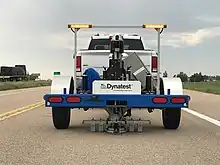

.jpg.webp)


A falling weight deflectometer (FWD) is a testing device used by civil engineers to evaluate the physical properties of pavement in highways, local roads, airport pavements, harbor areas, railway tracks and elsewhere. The data acquired from FWDs is primarily used to estimate pavement structural capacity, to facilitate overlay design or determine if a pavement is being overloaded. Depending on its design, a FWD may be contained within a towable trailer or it may be built into a self-propelled vehicle such as a truck or van. Comprehensive road survey vehicles typically consist of a FWD mounted on a heavy truck together with a ground-penetrating radar and impact attenuator.
During testing, a FWD subjects the pavement surface to a load pulse which simulates the load produced by a rolling vehicle wheel. The load pulse is produced by dropping a large weight onto a "buffer" which shapes the pulse, and then transmitted to the pavement through a circular load plate. Data are acquired from various sensors for use in post-test analysis of pavement properties. Deflection sensors are used to measure the deformation of the pavement in response to the load pulse. In some FWDs the magnitude of the applied load pulse is an assumed constant value determined by system design; in others the force is measured by load cells.
The load plate may be solid or segmented. Segmented load plates adapt to the shape of the pavement to more evenly distribute the load on uneven surfaces. The load plate diameter is typically 300 mm diameter on roads and 450 mm on airports, and the load for road testing is about 40 kN, producing about 567 kPa pressure under the load plate (50 kN / 707 kPa according to European standard).
Load impact system
There are two different types of load impact systems; single-mass and double-mass.[1][2]
In a single-mass system, a weight is dropped onto a single buffer connected to a load plate, which in turn rests on the surface being tested. Single-mass FWDs are typically smaller, faster and less expensive but, when used on soft soils, may overestimate the capacity of pavements due to the mass inertia of the pavement material.[3]
In a double-mass system, the weight drops onto an assembly consisting of a first buffer, a second weight, and a second buffer.[note 1] This produces a longer loading duration that more precisely simulates a wheel load, and yields higher reproducibility and gives a more accurate result on pavements built on soft soils.[4][5]
There are also combined single/double mass systems where the falling weight and middle weight can be locked together giving 150 kN short pulse. In unlocked mode the FWD works as a double mass system giving 50 kN long pulse.
In all systems, the load pulse shape and rise time is important because it can affect the peak values of center deflection by as much as 10% to 20%.[6]
Deflection sensors
Deflection sensors are used to measure the deformation of the pavement in response to the load pulse. The sensors are mounted radially from the center of the load plate at typical offsets of 0, 200, 300, 450, 600, 900, 1200 and 1500 mm (the deflections measured at these offsets are denoted D0, D200, D300, etc.).
Two types of deflection sensors are used: geophones and force-balance seismometers. Seismometers have built-in calibration devices and higher deflection measurement ranges (5 mm vs 2 mm). Geophones lack built-in calibration devices and are more sensitive to disturbances immediately before the impact since the initial error is integrated, but are much less expensive than seismometers.
Analysis
FWD data is most often used to calculate stiffness-related parameters of a pavement structure. The process of calculating the elastic moduli of individual layers in a multi-layer system (e.g. asphalt concrete on top of a base course on top of the subgrade) based on surface deflections is known as "backcalculation", as there is no closed-form solution. Instead, initial moduli are assumed, surface deflections calculated, and then the moduli are adjusted in an iterative fashion to converge on the measured deflections. This process is computationally intensive although quick on modern computers. It can give quite misleading results and requires an experienced analyst. Commonly used backcalculation software are:
- BAKFAA (Federal Aviation Administration)
- Clevercalc (University of Washington)
- ELMOD (Dynatest)
- Evercalc (WSDOT)
- KGPBACK (Geotran)
- MichBack (Michigan DOT)
- Modulus (TxDOT)
- PVD (KUAB)
- PRIMAX DESIGN / RoSy Design (Sweco, former Carl Bro)
Many analysts use simplified methods to calculate related parameters that are empirical in nature. The most common is maximum deflection under the centre of the load plate (D0) which is related to empirical measures such as the Benkelman Beam deflection (after minor adjustment for differences in the two devices). Historically some used the radius of curvature (D0-D200) but this is out of favour now because it is clear that the steel loading plate of 300mm diameter affects the shape of the deflection bowl between the centre (D0) and the D200 sensor at 200mm. However this means that a lot of useful information about the shape of the deflected bowl is wasted. Horak and Emery have published indices that use this information: BLI=D0-D300 and gives an indication of the basecourse performance, MLI = D300-D600 and gives an indication of the subbase performance, and LLI=D600-D900 and gives an indication of subgrade performance. These and other similar indices are known as shape factors. The FWD data can also be very useful in helping the engineer divide the length of the pavement into homogeneous sections.
FWD data can also be used to calculate the degree of load transfer between adjacent concrete slabs, and to detect voids under slabs.
Other models
Dynatest was the first company to develop the Light Weight Deflectometer (LWD) The Light Weight Deflectometer is a portable falling weight deflectometer used primarily to test in situ base and subgrade moduli during construction. LWD measurement is faster than the isotope measuring method and requires no reference measurements. The equipment has no radioactive sources and can be operated by one person, allowing for on-site data analysis and report printing.[7] Some LWDs have no load cell and assume a nominal load value, whereas others employ a load cell to measure the actual load. Depending on the system, a LWD may have a single geophone located in the centre or it may have two geophones, typically located at 300 and 600 mm positions.
A Fast Falling Weight Deflectometer (FFWD) is a FWD with pneumatic or electric actuators rather than hydraulic, making the mechanics several times faster.
A Heavy Weight Deflectometer (HWD) is a falling weight deflectometer that has higher loads (typically 300 kN to 600 kN), used primarily for testing airport pavements. A common misconception is that higher loads are needed to test an airport's capability to handle heavy aircraft, but in fact, the testing methods are not designed to test the strength of the construction but to find the material properties of the construction.
A Rolling Weight Deflectometer (RWD) is a deflectometer that can gather data at a much higher speed (as high as 55 mph) than the FWD, which allows the data to be collected without traffic control and lane closure.[8] It is a implemented as a tractor-trailer with laser measuring devices mounted on a beam under the trailer. Unlike the FWD, which pauses to make measurements, a RWD gathers deflection data while it travels.[9]
The test materials are described in ASTM D 4694, and the test method is defined in ASTM D 4695.140
Notes
- ↑ In a double-mass system, the principle of operation is based on the law of conservation of momentum with an elastic collision of two unequal masses.
References
- ↑ "KUAB two-mass FWD". Iowa State University. Retrieved 12 March 2014.
- ↑ "KUAB two-mass FWD patent". Google patents. Retrieved 6 July 2015.
- ↑ Crovetti, JA; Shahin, MY; Touma, BE (1989). "Comparison of Two Falling Weight Deflectometer Devices, Dynatest 8000 and KUAB 2M-FWD". Nondestructive Testing of Pavements and Backcalculation of Moduli. ASTM International. doi:10.1520/STP19799S. ISBN 978-0-8031-1260-5.
- ↑ Meier, Roger W. "Backcalculation of Flexible Pavement Moduli from Falling Weight Deflectometer Data Using Artificial Neural Networks" (PDF). US Army Corps of Engineers. Retrieved 24 January 2017.
- ↑ Shahin, M.Y. (2007). Pavement Management for Airports, Roads, and Parking Lots (2 ed.). US: Springer. ISBN 978-0387234656.
- ↑ "Testing Different FWD Loading Times". Bulletin. Stockholm, Sweden: Department of Highway Engineering, Royal Institute of Technology. 8. 1980.
- ↑ "Light Weight Deflectometer YouTube Video". Cooper Technology. Archived from the original on 2014-07-05. Retrieved 3 March 2014.
- ↑ Elbagalati, Omar; Elseifi, Mostafa A.; Gaspard, Kevin; Zhang, Zhongjie (16 June 2017). "Development of an Artificial Neural Network Model to Predict Subgrade Resilient Modulus from Continuous Deflection Testing". Canadian Journal of Civil Engineering. 44 (9): 700–706. doi:10.1139/cjce-2017-0132.
- ↑ "Megascale RWD patent". Google patents. Retrieved 29 October 2015.